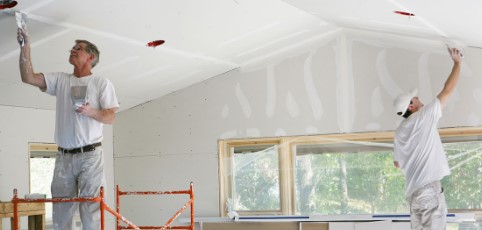A Comprehensive Guide to Choosing Drywall Repair and Replacement
A Comprehensive Guide to Choosing Drywall Repair and Replacement

When it comes to maintaining the integrity and aesthetics of your home, one aspect that often requires attention is your drywall. Drywall is an essential component of any interior space, providing structure and a smooth surface for paint and decoration. Over time, however, it’s not uncommon for drywall to develop issues such as cracks, holes, or water damage. In such cases, it becomes necessary to consider drywall repair or replacement. This comprehensive guide will walk you through the key factors to consider when making this decision, ensuring that you choose the best option for your specific situation.
Assessing the Damage
Before diving into the decision-making process, it’s essential to thoroughly assess the extent of the damage to your drywall. Small cracks and nail holes are common wear and tear issues that can be easily repaired with some spackling and paint. However, more significant damage caused by water leaks, impact, or structural issues might require more extensive attention.
If you’re uncertain about the severity of the damage, it’s advisable to consult with professionals. Searching for “drywall service near me” can help you find local experts who can provide an accurate assessment of the damage and recommend the appropriate course of action.
Repairing the Drywall
Minor cracks and holes can often be repaired without the need for full replacement. Drywall repair is a cost-effective solution that involves patching up damaged areas to restore the wall’s integrity and appearance. Here’s a breakdown of the repair process:
- Cleaning and Preparing the Area: Before any repairs can take place, the damaged area must be cleaned of debris, loose drywall, and any old adhesives or paints.
- Applying the Patch: A patching compound, such as spackling or joint compound, is applied to the damaged area. This compound is then smoothed out and left to dry.
- Sanding and Smoothing: Once the compound is dry, the repaired area is sanded down to achieve a smooth surface that blends seamlessly with the rest of the wall.
- Painting: The final step involves painting the repaired area to match the surrounding wall. This step is crucial for achieving a uniform and aesthetically pleasing finish.
Replacing the Drywall
In cases where the damage is extensive, or the structural integrity of the drywall is compromised, replacement might be the best option. Here’s what the replacement process entails:
- Removing the Damaged Drywall: The first step is to carefully remove the damaged sections of drywall. This can be a delicate process, especially if the damage extends to areas near electrical outlets or plumbing.
- Measuring and Cutting: New drywall sheets are then measured, cut, and fit into the empty space. Precision is key here to ensure a snug fit.
- Attaching the New Drywall: The new drywall is attached to the studs using screws or nails. Special attention is given to securing the edges and corners properly.
- Taping and Mudding: Seams between the new drywall sheets are covered with joint tape and multiple layers of joint compound (mud) are applied. This process creates a seamless surface.
- Sanding and Finishing: Once the mud is dry, the area is sanded to create a smooth texture. The entire wall is then primed and painted to match the rest of the room.
Factors to Consider
When deciding between repair and replacement, several factors come into play:
- Extent of Damage: The severity of the damage is a primary consideration. Small cosmetic issues can usually be repaired, but extensive damage might warrant replacement.
- Cost: Repairing drywall is generally more cost-effective than replacing entire sections. However, if the damage is widespread, replacement might be a more economical long-term solution.
- Time: Repairing minor damage is usually quicker than the replacement process, which involves more steps and drying time.
- Aesthetics: While repairs can often be made to blend in with the rest of the wall, replacement guarantees a completely uniform appearance.
- Structural Integrity: If the damage affects the structural integrity of the wall, replacement is likely the safer option.
Finding Professionals Near You
In many cases, especially when dealing with extensive damage or if you’re not confident in your DIY skills, it’s best to seek professional assistance. Searching for “drywall service near me” can help you find local contractors who specialize in drywall repair and replacement. When choosing a professional, consider their experience, reviews from past clients, and the quality of their work.
In conclusion, when faced with damaged drywall, it’s crucial to assess the extent of the damage and consider factors like cost, time, aesthetics, and structural integrity before deciding between repair and replacement. For minor issues, repairing the drywall can be a straightforward and cost-effective solution. However, if the damage is extensive or compromises the wall’s structure, replacement might be the better choice. Regardless of your decision, consulting with professionals in your area will ensure that your drywall is restored to its former glory, enhancing the overall look and value of your home.
